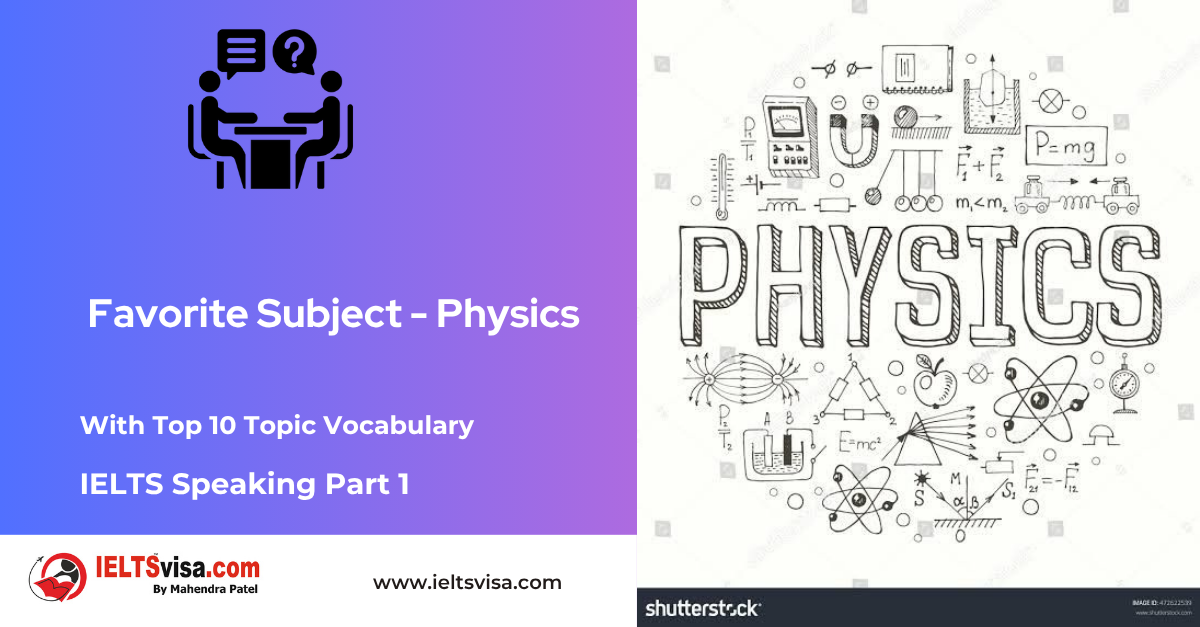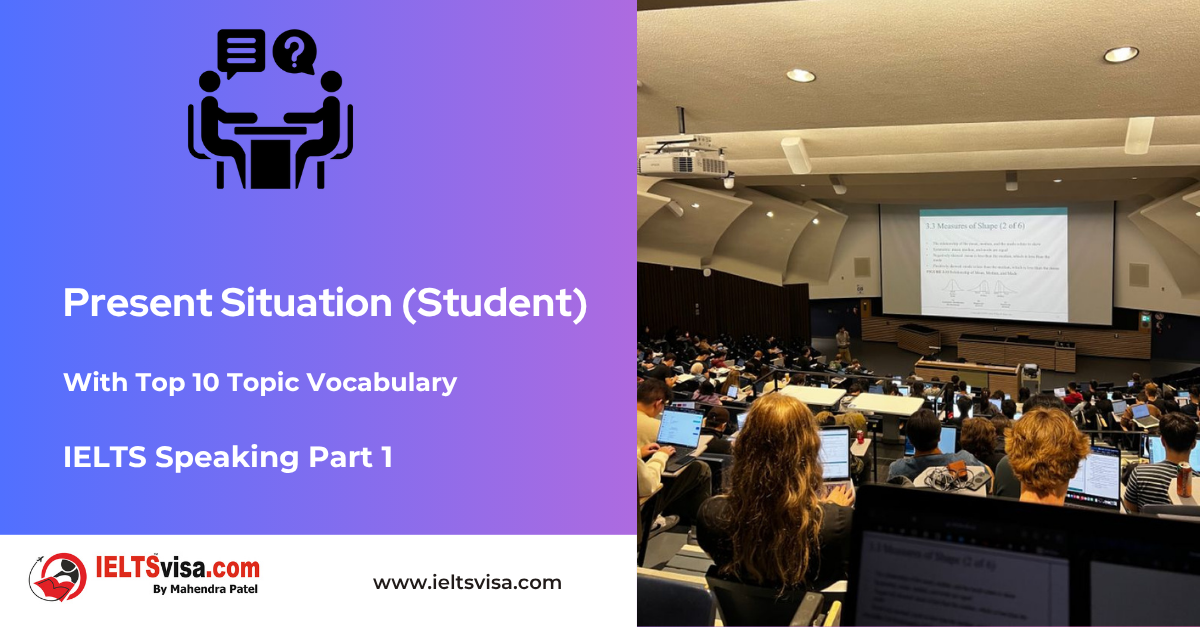Articles: “A,” “An,” and “The”
Grammar for IELTS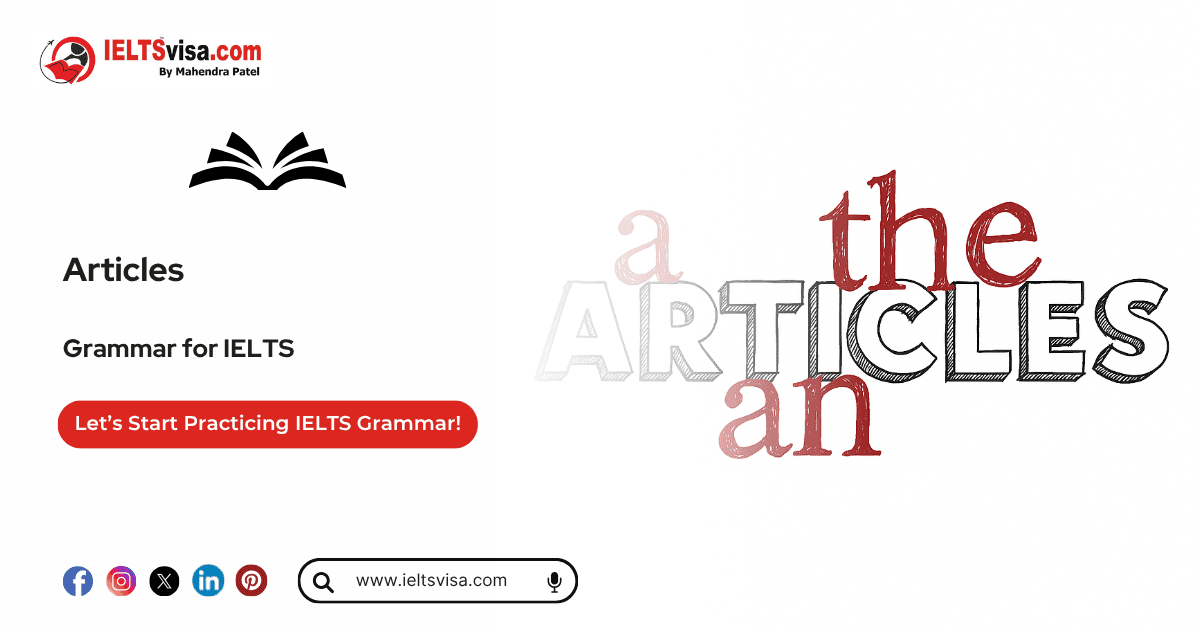
Articles: “A,” “An,” and “The”
Understanding Articles in English Grammar
In English, articles are words that define a noun as specific or unspecific. The three articles are:
-
-
-
-
“A” (indefinite)
-
“An” (indefinite)
-
“The” (definite)
-
-
-
1. Indefinite Articles: “A” and “An”
Use “a” or “an” to refer to non-specific nouns—something that is not previously known to the listener.
1. “A” is used before words that begin with a consonant sound.
Example: a cat, a car, a university (note: “university” starts with a “yoo” sound)
2. “An” is used before words that begin with a vowel sound.
Example: an apple, an hour, an MBA (note: “hour” starts with a silent “h”)
Examples:
-
-
I saw a bird in the tree.
-
Can I have an ice cream, please?
-
Definite Article: “The”
Use “the” when referring to a specific noun—something both the speaker and listener know about.
-
-
Example: the cat (a known cat), the apples (specific apples)
-
Examples:
-
-
The bird in the tree was singing loudly.
-
I want to buy the ice cream from that vendor.
-
Using “A/An” Before Adjective + Noun Phrases
When an adjective comes before a singular noun, choose “a” or “an” based on the sound of the adjective, not the noun.
Examples:
-
-
An old book (“old” begins with a vowel sound)
-
A new car (“new” begins with a consonant sound)
-
A unique perspective (“unique” starts with a “yoo” sound → consonant)
-
Noun Phrases with “A/An”
Countable Nouns:
Use “a” or “an” to refer to a single, countable noun.
-
-
-
A red apple
-
An old chair
-
-
Uncountable Nouns:
Do not use “a” or “an” with uncountable nouns.
-
-
-
Milk
-
Water pollution
-
-
Common Expressions with “A/An” in Noun Phrases
Some commonly used phrases use “a” or “an” to express general or non-specific ideas:
| Phrase | Example |
|---|---|
| A certain extent/degree | To a certain extent, the policy worked. |
| A wide variety/range | The shop offers a wide variety of products. |
| A large/small number/amount | A large number of attendees arrived early. |
| A high/small percentage | A small percentage of people voted. |
| A long time | It took me a long time to finish. |
| A significant amount | They spent a significant amount on research. |
| A good/bad idea | Starting early is a good idea. |
| An effective strategy | They implemented an effective marketing strategy. |
| A useful tool | This app is a useful tool for productivity. |
| A unique opportunity | This is a unique opportunity to learn. |
Using “The” with Abstract Nouns (Situations, Qualities, Changes)
While abstract nouns (ideas, processes, or conditions) often don’t require articles, use “the” when referring to a specific instance of such a concept.
Examples:
-
-
The rise of populism in Europe is concerning.
-
The process of globalization affects every nation.
-
The situation in the Middle East remains tense.
-
The change in consumer habits is driven by technology.
-
The development of new technologies fuels innovation.
-
More Abstract Noun Phrases with “The”
| Phrase | Example |
|---|---|
| The availability of housing | The availability of affordable housing is a growing issue. |
| The distribution of wealth | The distribution of wealth remains highly unequal. |
| The standard of living | The standard of living has improved in the past decade. |
| The frequency of extreme weather | The frequency of extreme weather is increasing. |
| The improvement of public transport | The improvement of public transport is vital for cities. |
| The state of the economy | The state of the economy influences political decisions. |
| The impact of technology | The impact of technology on jobs is widely debated. |
| The nature of human behavior | The nature of human behavior is central to psychological studies. |
| The level of education | The level of education in rural areas needs improvement. |
| The extent/scope of the problem | The scope of poverty extends beyond income to access to health and education. |
| The complexity of the situation | The complexity of the situation calls for diplomacy. |
| The level of risk | The level of risk in high-adrenaline sports is substantial. |
Summary
| Article | Use For | Example |
|---|---|---|
| A / An | Unspecific, singular countable nouns | a dog, an idea |
| The | Specific nouns (known to the speaker/listener or widely known concepts) | the dog, the internet |
| (No article) | Uncountable nouns and plural nouns when speaking generally | milk, books are useful |
Examples: Using “a” or “an” before Adjective + Noun Combinations
The choice between “a” and “an” depends on the sound at the beginning of the word that immediately follows the article—not necessarily the first letter. Here are some examples that illustrate this rule clearly:
1. An old book – “An” is used because “old” begins with a vowel sound, even though “book” begins with a consonant.
2. A new car – “A” is used because “new” begins with a consonant sound, even though “car” starts with a vowel letter.
3. A big house – “A” is correct here because “big” starts with a consonant sound, as does “house.”
4. An interesting article – “An” is used because “interesting” begins with a vowel sound, despite “article” starting with a consonant letter.
5. A unique perspective – “A” is correct because “unique” starts with a “yu” sound (a consonant sound), not a vowel sound.
6. A good idea – “A” is used because “good” begins with a consonant sound, even though “idea” starts with a vowel.
7. A part-time job – “A” is used because “part-time” begins with a consonant sound, and “job” also starts with one.
8. A very important issue – “A” is appropriate here because “very” begins with a consonant sound, even though “issue” starts with a vowel.
When to Use “A” or “An” Before Adjective + Noun
| Phrase | Starts With (Sound) | Use | Explanation |
|---|---|---|---|
| An old book | Vowel sound (old) | An | “Old” begins with a vowel sound. |
| A new car | Consonant sound (new) | A | “New” begins with a consonant sound. |
| A big house | Consonant sound (big) | A | “Big” begins with a consonant sound. |
| An interesting article | Vowel sound (interesting) | An | “Interesting” starts with a vowel sound. |
| A unique perspective | Consonant sound (yu-nique) | A | “Unique” starts with a “yu” sound (consonant sound), not a vowel sound. |
| A good idea | Consonant sound (good) | A | “Good” begins with a consonant sound. |
| A part-time job | Consonant sound (part-time) | A | “Part-time” begins with a consonant sound. |
| A very important issue | Consonant sound (very) | A | “Very” begins with a consonant sound, even though “issue” begins with a vowel. |

Using “A” and “An” in Noun Phrases
Indefinite articles “a” and “an” are often used in noun phrases to express something general, nonspecific, or approximate—rather than exact quantities or identified items. The choice between “a” and “an” depends on the sound that follows (not just spelling).
1. Quantity and Measurement
These noun phrases use “a/an” to express an unspecified amount or approximate range:
1. A large/small/equal number/amount
“A large number of people attended the event.”
2. A high/low/small/greater proportion/percentage
“A small percentage of the population has access to clean water.”
3. A significant/considerable amount
“The company invested a significant amount of money in research and development.”
4. A wide range/variety
“The store offers a wide variety of products.”
5. A long time
“It took me a long time to complete the project.”
6. A great deal
“I was able to get a great deal on the new car I purchased.”
2. Ideas, Thoughts, and Judgments
These phrases describe opinions, ideas, or conceptual evaluations:
1. A good/bad idea
“Starting a business can be a good idea, but it requires careful planning.”
2. An effective/ineffective strategy
“The company implemented an effective marketing strategy.”
3. A unique perspective
“Her background gives her a unique perspective on cultural issues.”
4. A perfect example
“The film is a perfect example of visual storytelling.”
3. Processes and Practices
Used to describe actions, habits, or standard procedures:
1. A common practice
“Using social media for marketing is a common practice.”
2. A necessary step
“Filling out the form is a necessary step in the application process.”
3. A new approach
“The company is taking a new approach to customer service.”
4. Factors and Considerations
These phrases refer to abstract or subjective components of situations:
1. An important factor
“Communication is an important factor in team success.”
2. A certain extent/degree
“To a certain extent, the policy worked.”
3. A useful tool
“The software is a useful tool for project management.”
5. Change and Outcome
Describing results, transformations, or consequences:
1. A big/small change
“The new manager brought about a big change in the office.”
2. A successful outcome
“The project had a successful outcome thanks to teamwork.”
Summary
| Category | Example Phrase | Usage Example |
|---|---|---|
| Quantity | A wide variety | “They offer a wide variety of snacks.” |
| Ideas & Evaluations | A good idea | “That’s a good idea!” |
| Strategies & Practices | An effective strategy | “They used an effective strategy.” |
| Abstract Concepts | An important factor | “Trust is an important factor.” |
| Change & Result | A successful outcome | “It was a successful outcome.” |
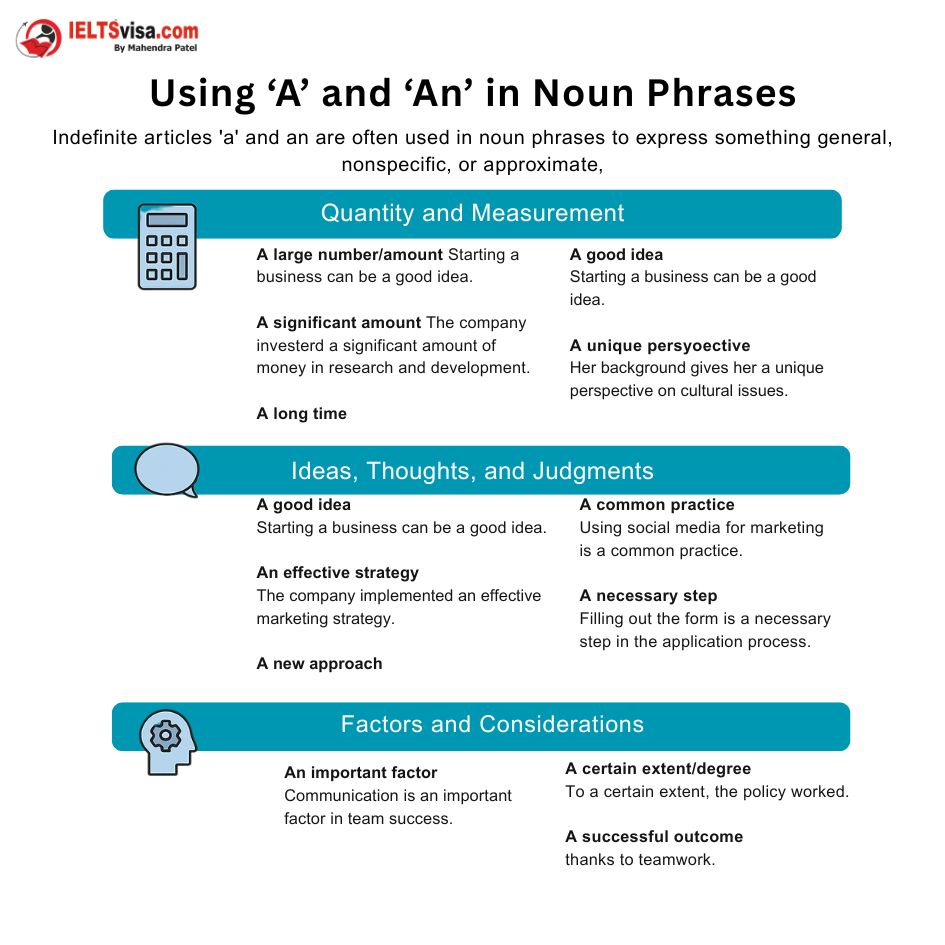
Using “The” Before Abstract Nouns
General Rule
In general, “the” is not used before abstract nouns that refer to:
-
-
- Situations
- Qualities
- Processes
- Changes
-
However, “the” can be used when referring to a specific instance or when aiming to give a more precise or contextual meaning.
Examples of Abstract Nouns with “The”
1. Situation
- The situation in the Middle East
→ Refers to a specific situation in the region.
2. Process
-
The process of globalization
→ Highlights a specific process, not the general idea. - The development of new technologies
→ Points to particular technological advancements driving economic growth.
3. Change
-
The change in consumer behavior
→ Indicates a specific shift, such as increased online shopping. -
The improvement of public transportation
→ Refers to a needed or observed improvement in a specific context.
4. Quality
-
The quality of education in this school
→ Describes the specific standard at a particular school. -
The quality of healthcare
→ Refers to specific standards or availability in a region or country.
Other Common Abstract Nouns with “The”
5. Rise / Increase / Growth
-
The rise of populism in Europe
→ Refers to a distinct political trend. -
The frequency of extreme weather events
→ A specific pattern or increase linked to climate change.
6. Distribution / Availability
-
The distribution of wealth in this country
→ Refers to how wealth is shared, highlighting inequality. -
The availability of affordable housing
→ Discusses a specific issue in urban planning.
7. Level / Extent
-
The standard of living
→ Refers to a specific level of comfort or quality of life. -
The level of education
→ Describes a specific educational attainment in a population. -
The level of risk
→ Indicates a particular degree of danger (e.g., in activities or investments). -
The extent of the problem
→ Describes how severe or widespread an issue is.
8. Nature / Scope / Complexity
-
The nature of human behavior
→ Refers to specific characteristics or theories of behavior. -
The scope of the problem
→ Addresses how broad or far-reaching a problem is. -
The complexity of the situation
→ Emphasizes how intricate or difficult a specific situation is.
9. Impact / Outcome / Opportunity
-
The impact of technology
→ Refers to specific effects on jobs, society, or economy. -
The successful outcome of the project
→ Points to a particular result achieved. -
The unique opportunity presented by the conference
→ Highlights a one-of-a-kind situation.
Summary
Using “the” before abstract nouns allows writers and speakers to:
-
-
Emphasize a specific aspect or instance
-
Add precision and clarity
-
Contextualize broad concepts
-
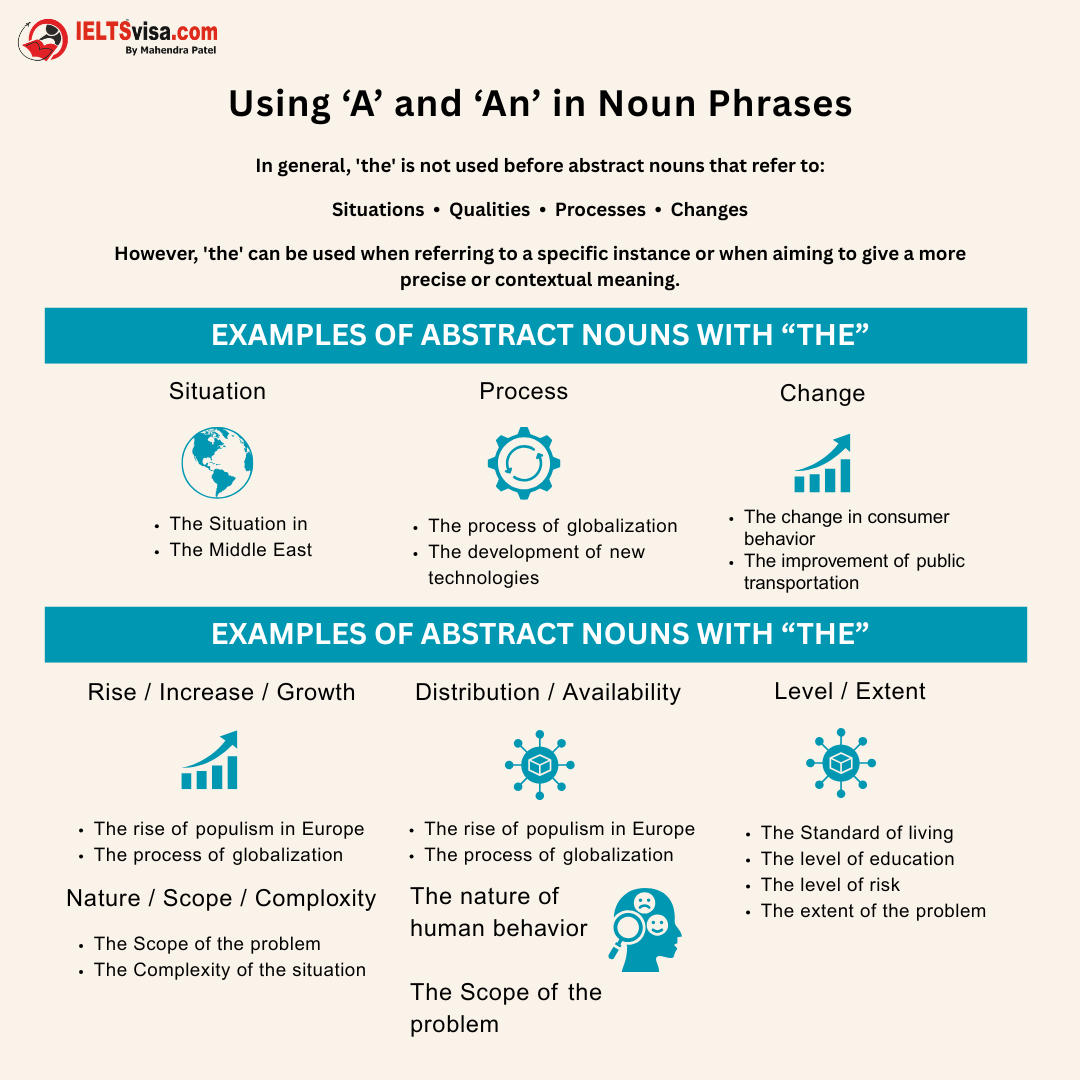
Using “The” in IELTS-Level Sentences
“The” is commonly used in IELTS writing and speaking to specify a particular concept, entity, or group. Below are examples of high-level sentence constructions with explanations:
Government and Institutions
1. “The government needs to take action to reduce pollution.”
→ Refers to the specific government of the speaker’s country; suggests responsibility.
2. “The education system in this country needs to be reformed.”
→ Identifies the national education system and calls for change.
Technology and Innovation
3. “The Internet has transformed the way we communicate.”
→ Specifies the Internet as a unique invention with major societal impact.
4. “The rise of automation and artificial intelligence is transforming the job market.”
→ Indicates a specific technological trend influencing employment.
Business and Economics
5. “The company’s profits have been steadily declining for the past five years.”
→ Refers to a particular company; highlights its financial trend.
6. “The global economy is becoming increasingly interconnected and interdependent.”
→ Describes a well-defined economic system with growing links.
Media and Communication
7. “The media is responsible for reporting the news accurately and objectively.”
→ “The media” refers to a collective group with journalistic duties.
8. “The impact of social media on young people’s mental health is a growing concern.”
→ Emphasizes a particular effect social media has on mental health.
Social and Environmental Issues
9. “The majority of people in this country speak English as their first language.”
→ Points to a defined demographic group within a specific location.
10. “The use of renewable energy sources is essential to combat climate change.”
→ Focuses on a defined strategy or practice to address global warming.
Health and Lifestyle
11. “The benefits of regular exercise cannot be overstated.”
→ Highlights a specific aspect of exercise: its advantages.
Education and Learning
12. “The study of history helps us to understand the present and plan for the future.”
→ Refers to a defined field of academic discipline.
Summary
The definite article “the” is used in IELTS-level English to:
-
-
Specify known entities or concepts
-
Refer to shared knowledge or context
-
Emphasize responsibility, significance, or impact
-
Use “the” thoughtfully to clarify your message and demonstrate grammatical precision in your writing and speaking tasks.
Using “The” in IELTS Writing Task 1
In IELTS Writing Task 1, the definite article “the” is commonly used to refer to specific visual data provided in the prompt. Here’s a breakdown of how “the” is used in different task types:
1. Tables
“The table below shows the number of tourists who visited a particular country between 2015 and 2019.”
→ “The” refers to the specific table presented in the task.
“The table below shows the percentage of people in a particular country who use public transportation to commute to work, broken down by gender and age group.”
→ “The” refers to the specific table showing public transport usage data.
“The table below shows the average number of hours worked per week by people in different professions in a particular country.”
→ “The” identifies the specific table showing average weekly work hours.
2. Graphs
“The graph below shows the number of cars per household in a particular city from 2000 to 2020.”
→ “The” refers to the specific line or bar graph in the task.
“The graph below shows the amount of money spent on advertising by a particular company in different media formats over a five-year period.”
→ “The” refers to the specific graph tracking advertising expenses.
3. Charts
“The chart below shows the percentage of people in a particular country who engage in different types of physical activity, broken down by age group.”
→ “The” indicates the specific pie or bar chart showing physical activity statistics.
4. Maps
“The map below shows the changes in a particular city’s downtown area between 2000 and 2020.”
→ “The” refers to the specific map illustrating city layout changes.
“The map below shows the location of a proposed new housing development.”
→ “The” identifies the specific map with the development site..
5. Maps
“The diagram below shows the process of recycling plastic bottles.”
→ “The” refers to the specific process diagram shown in the prompt.
“The diagram below shows the layout of a proposed new shopping mall.”
→ “The” identifies the specific layout diagram provided.
Summary: Why “The” Is Used
In IELTS Task 1:
-
“The” helps the writer refer precisely to the data source (table, graph, map, etc.).
-
It ensures clarity by pointing to a known and visible object the examiner and candidate are both referencing.


Our Books
Master IELTS Speaking Part 1
IELTS Writing Task 1 Book
IELTS Writing Task 2 Book
Practice IELTS Other Modules
IELTS Listening
The IELTS Listening test assesses how well you can understand spoken English in various contexts. It lasts about 30 minutes and is divided into four sections with a total of 40 questions. The listening tasks become increasingly difficult as the test progresses.
IELTS Academic Reading
The IELTS Academic Reading section assesses your ability to understand and interpret a variety of texts in academic settings. It is designed to evaluate a range of reading skills, including skimming for gist, reading for main ideas, reading for detail, understanding inferences, and recognizing a writer's opinions and arguments.
IELTS Speaking
The IELTS Speaking test assesses your ability to communicate in English on everyday topics. It lasts 11-14 minutes and consists of three parts: introduction, cue card, and a discussion based on the cue card topic.
IELTS General Reading
IELTS General Reading tests your ability to understand and interpret various types of texts. Here are some key areas and types of content you can expect to encounter in the reading section, along with tips for effective preparation.
IELTS Academic Writing Task 1
In IELTS Academic Writing Task 1, you are presented with a visual representation of information, such as graphs, charts, tables, or diagrams, and you are required to summarize, compare, or explain the data in your own words.
IELTS General Writing Task 1
In IELTS General Writing Task 1, you are required to write a letter based on a given situation. The letter can be formal, semi-formal, or informal, depending on the prompt. Here’s a breakdown of the key components to include in your letter
IELTS Academic Writing Task 2
In IELTS Academic Writing Task 2, you are required to write an essay in response to a question or topic. Here’s a guide to help you understand the essential elements of this task
IELTS Exam Tips
To succeed in the IELTS exam, practice regularly, familiarize yourself with the test format, improve your vocabulary, develop time management skills, and take mock tests to build confidence.
Grammer for IELTS
Grammar is the foundation of effective communication in English. Understanding tense usage, subject-verb agreement, and sentence structure enhances clarity and coherence in writing and speaking.
Vocabulary for IELTS
Vocabulary plays a crucial role in the IELTS (International English Language Testing System) exam, especially in the Speaking and Writing sections. Here’s an overview of why vocabulary is important and how it impacts your performance
RECENT IELTS SAMPLES QUESTIONS AND ANSWERS
IELTS Speaking Part 1 – Favourite Sujbect – Physics
IELTS Speaking Part 1 - Favourite Sujbect - Physics Q: What is your favourite subject? A: My favourite subject...
IELTS Speaking Part 1 – Present Situation (Student)
IELTS Speaking Part 1 - Present Situation (Student) Q1: Are you a student or do you work?A: I’m a full-time...
IELTS Speaking Part 1 – Present Situation – Employee – as an International Student and Social Worker
IELTS Speaking Part 1 - Present Situation - Employee - as an International Student and Social Worker Q1: Are...
IELTS Speaking Part 1 – Persent Situation – Employee- as an Electric Engineer
IELTS Speaking Part 1 - Persent Situation - Employee- as an Electric Engineer Q1: What do you do for a...
IELTS Speaking Part 1 – Persent Situation – Employee – as an Software Engineer
IELTS Speaking Part 1 - Persent Situation - Employee - as an Software Engineer Q1: What do you do for a...
IELTS Speaking Part 1 – Persent Situation – Married
IELTS Speaking Part 1 - Persent Situation - Married Q1: Are you married?A: Yes, I am married. My spouse and I...








